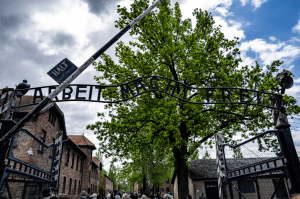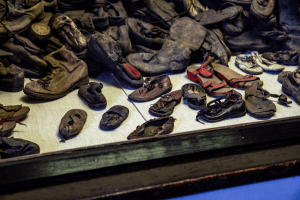Meandering through the national memorials of fallen soldiers from the Soviet Union, Germany, and America, I noticed that each country’s displays of mourning were fundamentally different in grandeur. Acting as a representation of the nation’s status at war’s end, the gravesites t old a deeper story than a first glance allows.
old a deeper story than a first glance allows.
The American site sits on the Normandy coast. Alongside the memorial is the beach where so many Americans initiated the fateful invasion of Europe. Crashing waves and chirping birds fill the air. With the bright marble gravestones and perfectly kept grass, I got the sense that in the wake of tragedy, America was proud of its contribution. Each deceased soldier also rested in a plot of their own, showing an appreciation for the sacrifices of the individual.
A different story emerged when entering the Soviet memorial in Berlin. The landscape is expansive. A vast swath of grass leads to the statue of a Soviet soldier holding a child in one hand and a sword in the other. Pinned underneath the sword is a Nazi swastika, crushed into several pieces. The statue stands hundreds of feet tall and seems more like a monument to an omnipotent nation in a dystopian movie rather than a memorial to perished troops. So imposing and grandiose is the monument that it totally distracted me from the fact that thousands of Soviet soldiers were buried on-site. I got the sense that I was not supposed to leave remembering the countless Soviet deaths, but instead the USSR’s brazen defeat of Nazi Germany. Really, just as in the war, consideration of individual Soviet lives seemed to be secondary to the maintenance of a titanic national image.
Finally, the memorial to German soldiers told a story of shame. Beneath each faded, jagged gravestone lay two or more soldiers. At the center of the site is a large mound, wherein hundreds more soldiers are buried. The surrounding scenery is bare; trees and bushes scatter the site in haphazard formation. The cemetery is devoid of flourish and commemorative depth, demonstrating Germany’s willingness to shamefully swallow its losses.
 Each national memorial was designed to tell a particular story— a story of vanquish or victory. Even an untrained eye can notice the differences of each site, but having an understanding of history allowed me to appreciate the deeper meaning of these differences.
Each national memorial was designed to tell a particular story— a story of vanquish or victory. Even an untrained eye can notice the differences of each site, but having an understanding of history allowed me to appreciate the deeper meaning of these differences.


